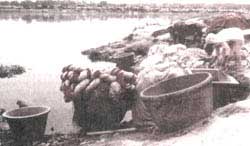Washing water
 A TEAEM of researchers from the Banaras Hindu University in Varanasi, Uttar Pradesh, has isolated two fungal and one bacterial strains which are capable of removing colour and heavy metals from polluted water. Mycologist R S Upadhyay and his research-studen( R K Maurya are striving to develop a water treatment technology based on the use of these microbial strains which have been named RKM-1, RKM-2 and RK&f-3 respectively.
A TEAEM of researchers from the Banaras Hindu University in Varanasi, Uttar Pradesh, has isolated two fungal and one bacterial strains which are capable of removing colour and heavy metals from polluted water. Mycologist R S Upadhyay and his research-studen( R K Maurya are striving to develop a water treatment technology based on the use of these microbial strains which have been named RKM-1, RKM-2 and RK&f-3 respectively.
Varanasi is a major centTC for the manufacture of sarees (traditional dress worn by Indian women) and carpets - industries in which large amounts of synthetic dyes are used. Effluents com- ing out from these units are loaded with synthetic dyes and colours containing various kinds ef highly toxic heavy metals such as copper, lead, chromium, zinc and cadmium. These metals are known to hamper life processes in aquatic plants and animals. Besides, they are carried to other animals and human beings through the food chain and drinking water, causing various diseases as a consequence. Upadhyay is optimistic about developing a cheap indigenous technology for Pollution control in the local units.
Effluents loaded with dyes directly affect the transparency of water bodies. Decline in transparency means that lesser light enters these bodies and there is a reduction in photosynthetic activity. Any decline in photosynthesis affects the entire aquatic system, most pro- minently its oxygen content. Decrease primary production of oxygen creates distortions in the food chain. In extreme cases, an entire water body may become lifeless.
The new microbial strains remove colour as well as heavy metals from polhated water, thereby making it colourless and non-toxic. Laboratory tests have shown that they are highly effiderlt. RKM-1 and RKM-2 belong to the filamentous group of lungi, which have fine thread-like filaments on their body. They reproduce fast by simple cell division and within a short span of time, they can grow into a thick filamentous Mat. RKM-3 is a species of pseudomonas (rod-shaped bacteria generally found in soil) which grows very fast. It is not yet known how these fungi mike the water clean. Fungi have several mechanisms which help them actively accumulate different kinds of pollutants. Upadhyay and Maurya are trying to explore what mechanisms are being utilised by these strains.
One possible method is that metals are being adsorbed through the wails of the fungi] cells. This process of active bioaccumulation could help the fungi collect large amounts of heavy metals in layers of their cell wails. For decomposition of dyes, they may be using the peroxiclase group of enzymes which are strong oxidising agents. Upadhyay believes that the fungal strains oxidise dyes with the help of these enzymes and make the water colourless. If the two researchers succeed in their efforts, Varanasi's waters will never be the same again.
Related Content
- Compliance affidavit by Tahasildar, Jaleswar, District Balasore regarding sand walls being erected in Subarnarekha, Balasore, Odisha, 22/04/2025
- Inspection report of the joint committee on Nabinagar Super Thermal Power Station and Bhartiya Rail Bijlee Company, Nabinagar, Aurangabad, 26/11/2024
- 2024 water funding gap report
- Affidavit on behalf of Deputy Commissioner, South Garo Hills district, Baghmara on a stone quarry in Budugre, 03/03/2024
- Order of the National Green Tribunal regarding red category polluting units operating in residential areas of Lal Kuan, Delhi, 28/11/2023
- Progress on sanitation and hygiene in Africa 2000-2022
